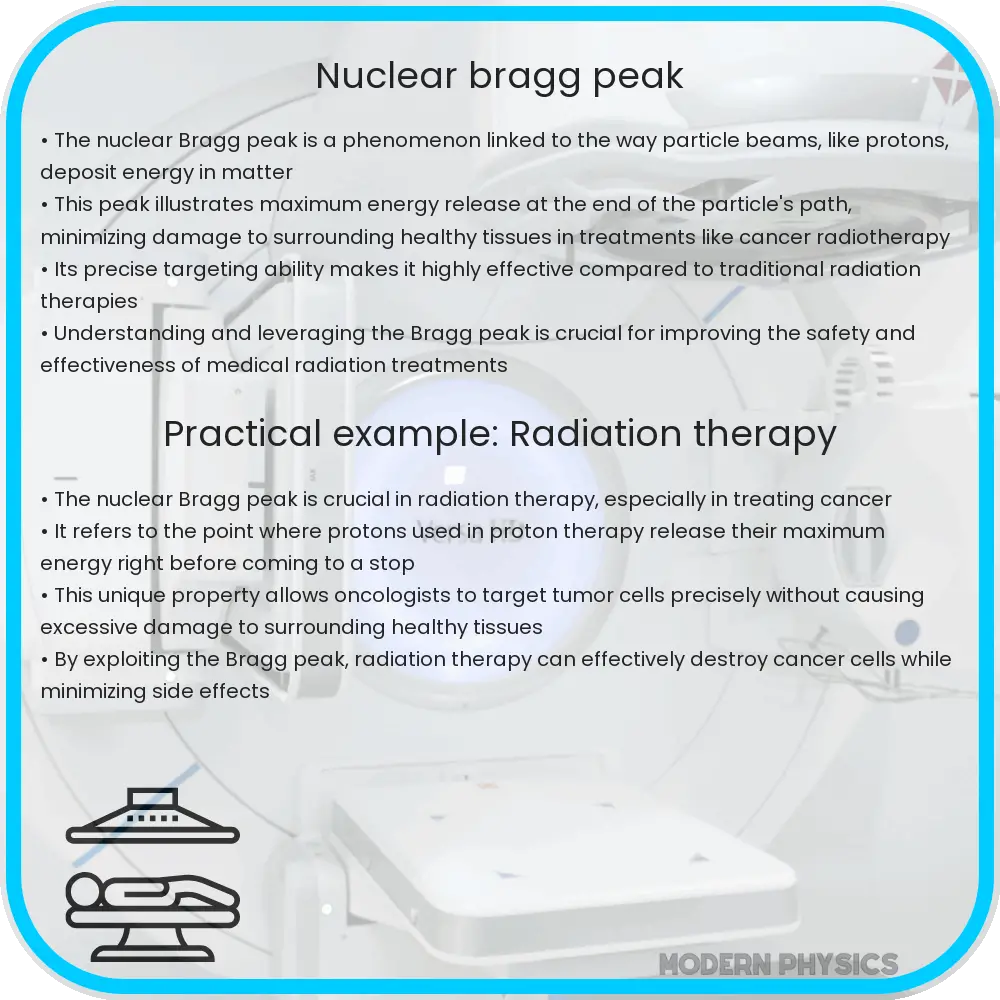Main keyword: Bragg Peak. A phenomenon where charged particles like protons release a maximum amount of energy at a specific tissue depth, ideal for targeted cancer treatments.

Understanding the Nuclear Bragg Peak
The Bragg Peak is a concept that plays a crucial role in the field of nuclear physics, particularly in the area of medical physics. It refers to a pronounced peak on the dose-depth curve created by ionizing particles as they pass through a medium, such as human tissue. Understanding this phenomenon is essential for the development and improvement of cancer treatment techniques, especially in proton therapy.
When charged particles, such as protons used in cancer treatments, enter a medium, they start to lose energy gradually. This energy loss typically intensifies as the particle penetrates deeper into the medium. However, there is a specific depth, known as the Bragg Peak, where these particles release a significant amount of their remaining energy in a very localized region. Beyond this peak, the energy rapidly drops off, minimizing the dose to the tissues situated further along the particle’s path. This characteristic makes Bragg Peak extremely valuable for targeting tumors while sparing the surrounding healthy tissues as much as possible.
Formation of the Bragg Peak
The formation of the Bragg Peak is primarily a result of two competing processes affecting the particle as it travels through a material: ionization and scattering. Ionization, where the particle interacts with electrons in the material, leads to energy loss and thus slows down the particle. Scattering, on the other hand, involves the directional change of the particle due to collisions with nuclei. It doesn’t significantly contribute to energy loss initially but affects the path and spread of the particle.
At the beginning of its journey through tissue, a proton or other particle has a high energy level and passes through the material with relatively little interaction. As the particle slows down, energy loss per unit length increases due to increased interactions with atomic electrons. The loss reaches its maximum at the Bragg Peak. Immediately after this peak, the particle’s energy rapidly diminishes until it stops.
Physical Explanation and Mathematical Description
To model the behavior of particles exhibiting the Bragg Peak, the Bethe formula is commonly used. This formula approximates the energy loss per unit distance (\( -\frac{dE}{dx} \)) of a charged particle traveling through a material as:
\[ -\frac{dE}{dx} = K \frac{Z^2}{A \beta^2} \left(\ln \frac{2m_e c^2 \beta^2}{I} – \beta^2 \right) \]
Where \( K \) is a constant, \( Z \) is the atomic number of the medium, \( A \) is the atomic mass, \( \beta \) is the velocity of the particle relative to the speed of light, \( m_e \) is the electron mass, \( c \) is the speed of light, and \( I \) is the mean excitation potential.
This formulation shows that the stopping power, and thus the Bragg Peak, is influenced by both the properties of the particle (like its initial energy and type) and the medium through which it is traveling. Adjustments in either can manipulate the depth and shape of the peak, providing a powerful tool for targeting diseases like cancer with precision.
Uses of the Bragg Peak in Medical Applications
The unique properties of the Bragg Peak are exploited extensively in hadron therapy, which includes proton therapy and carbon ion therapy. These therapies are used to treat various types of cancer by directing a high-energy beam of particles to the tumor site. The ability to concentrate a large dose of radiation at a specific depth allows oncologists to maximize the dose delivered to the tumor while minimizing the exposure to surrounding healthy tissues.
This technique is particularly beneficial for treating tumors that are located close to critical organs and structures, as it provides a greater degree of precision compared to traditional radiation therapy methods. Moreover, the sharp dose falloff beyond the Bragg Peak helps in sparing the deeper tissues, which is crucial when the tumor is overlaid by sensitive structures.
Beyond cancer treatment, research into the Bragg Peak’s applications is also exploring its use in other medical fields, such as the targeted delivery of drugs and imaging enhancements. The precise control over energy deposition could revolutionize how treatments are delivered and how diseases are diagnosed.
Challenges and Future Prospects
Despite its significant advantages, the application of the Bragg Peak in medical treatments faces several challenges. One major issue is the need for precise calculation and delivery of the particle beam. Slight miscalculations or movements (such as patient shifting during treatment) can lead to off-target radiation doses, which could damage healthy tissues or miss the tumor. Advanced imaging and real-time monitoring technologies are continually being developed to address these challenges.
Another challenge is the high cost and complexity of setting up and maintaining the equipment required for proton therapy and other hadron therapies. This makes such treatments less accessible in many parts of the world. Research is ongoing to develop more cost-effective equipment and methods that could make these life-saving treatments more widespread.
Future advancements aim to enhance the precision and effectiveness of the Bragg Peak utilization. Innovations such as the development of new particle types or composite materials for beam modulation promise to further refine this therapy. Additionally, combining hadron therapy with other forms of treatment, like chemotherapy or immunotherapy, could lead to better overall cancer treatment outcomes.
Conclusion
The Bragg Peak represents a pivotal concept in the intersection of physics and medicine, offering a targeted approach to cancer treatment that minimizes harm to healthy tissues. While it presents both challenges and opportunities, the ongoing research and technological developments continue to enhance its efficacy and accessibility. As we advance our understanding and capabilities in using this phenomenon, the potential for improving patient outcomes and expanding its applications in medicine grows. The Bragg Peak not only exemplifies a fascinating application of nuclear physics but also underscores the potential for scientific principles to make a real-world impact on human health.
